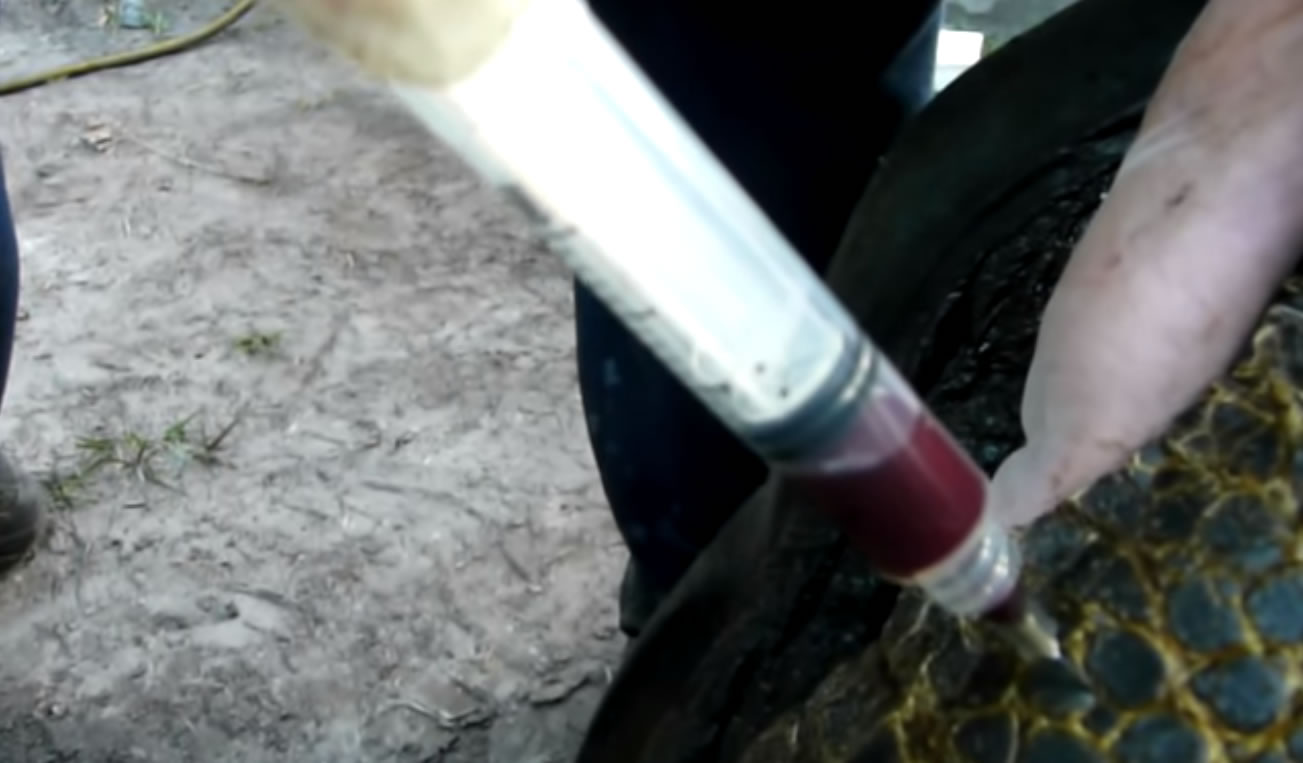Giving a large tortoise a shot
Several people have asked me, How do you give a large tortoise an injection?" If you have a large tortoise that is still fairly strong it can be a daunting task to pull out his leg in order to get to the inside leg to find the deep muscle.
I have made two examples: the first three pictures show injecting sites for a Leopard Tortoise, which is 4kg. (Just about 9 pounds)
The last two pictures are of a 60 pound spur tortoise. The concept discussed here holds true for all large tortoises, all the way up to our 600 pound Galapagos.
In this procedure it is actually better to force the leg in rather then try to pull it out. This gives you a lot more control over the injection; the last thing you want is a tortoise with a needle in his flailing leg.
The injection site is at the bottom part of the leg. (the part of the leg that is closest to the ground) The top part of the leg has less muscle and more bones, so you want to avoid that area. Flip the tortoise over and locate the bottom part of the leg that is close to the wrist. Now if you probe along the area with your finger or another device such as a pen you can actually feel the soft muscle.
You need to feel the muscle first so that you have an idea of where you are going to inject. As you travel up the leg towards the body or towards the top of the leg, you will notice that you can't detect that soft muscle. You will also notice the scales get much smaller when you are close to the injection area. Stay away from the large spurs or scales. Another important part of this procedure is to use the appropriate needle size; if the needle is too long than that is not good and neither is it being too short. Your vet will supply you with the proper needle size.
Important: please note in the pictures how I am holding the syringe in such a manner that even if the animal were to pull his leg in, the shell would not hit the needle or the syringe. The needle is somewhat parallel to the bottom of the tortoises shell. Never inject perpendicular to the bottom of the shell. The idea is that if the tortoise pulls in that leg he will bend (and could even break) the needle in his arm.
Clean the injection site, use alcohol and scrub the area. Many times I first have to use a scrub brush with soap and water and then scrub again with alcohol. After you have selected your injection site and the needle is in, before delivering the drug gently pull back on the syringe and check to see if you can see blood coming in the tip of the syringe. If you see blood you have hit a vein or artery and you will need to select another location typical I move to the other leg.
As you are delivering the drug with a slow and even push be prepared to let the syringe go if the tortoise suddenly moves his leg. You don't want to be jamming or bending that needle in his arm, it is better to just let it go.
Remember this procedure is to actually force the leg into the shell as this helps to immobilize the leg. As always, be careful for the tortoise may have different ideas. After you have selected your injection site direct the needle into the deeper muscle, you don't want to be too close to the surface of the skin as you're trying to get the drug into the muscle. Make sure that you're not close to the edge of the leg so that you go right through the leg.
Summary
- Flip the tortoise over.
- Force the leg in.
- Probe the injection site first until you detect the soft muscle.
- Alcohol scrub the site.
- Inject on the bottom or underside of the leg.
- Inject around the small scales and stay away from the large scales.
- Pull back to check for blood.
- Guide the needle towards the deeper muscle.
- Hold pressure on the site for a minute so that the drug doesn't leak out of the puncture wound.
- Alternate legs when you are injecting. Don't keep injecting the same site in the same leg day after day. Move from left to right.
- Keep records; the drug, the dose and the site.
Date: March, 07 2011
Sam Pascucci
Tortoise Injection Photos


